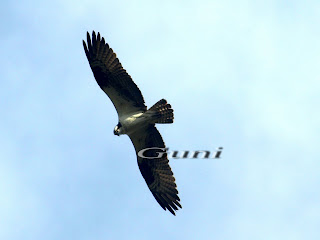 |
| Catbird in shadow |
Every animal has it's own voice, so it is expected that a dog will bark and a horse whinny. This is in part how we recognize the animals around us. However, as I recently learned, sometimes what you hear may be in a place where you do not expect it, nor connect with what you know, and eventually see. In this case I was surprised to hear a cat's repeated meow as I was concentrating on photographing some Red Tailed hawks. What would a cat be doing near a hawk's nest after all?
 |
| Gray Catbird just a glimpse |
So the meow was a sound I just couldn't ignore, and not only because it was insistent. It was very distracting, coming as it was from a dense group of dogwood bushes very near me. Naturally I looked low to the ground for the "cat" and under the bushes, only to realize that the meow was coming from the top. Here I glimpsed a fair sized gray bird with a long tail and a brief flash of red, and as I searched, the meow became more alarmed than insistent. It didn't take long for me to realize that the meow was being voiced by this bird. I was immediately enchanted, especially since I am always on the lookout for something new to me.
 |
| Gray Catbird clear image |
I learned later, this is a Gray Catbird, and the meow is a natural part of the male's territorial song. The flash of red I saw, was the Catbird flashing his red under tail coverts. This particular bird, wouldn't come out of hiding, so I only managed to get a few shadowy images. However, I lucked out this week, when I saw a member of the species in another location, where I surprised both myself, and the Catbird by capturing its image.
 |
| Gray Catbird a close-up |
The Gray Catbird, as you may have guessed, does not like to come out into the open. This bird is overall gray in color with a black cap and rusty red patch beneath it's tail. They have a slim, straight bill and a long rounded tail, which is black. They are known, in addition for their meow, to mimic other birds, much like the Mockingbird to whom they are related. They prefer dense bushes, such as dogwood to forage for food, but also forage on the ground. Their diet consists of mainly insects. When the male sings, the female will sometimes sing the song back to him. The male's song can last for up to ten minutes during courtship.
Enjoy,
Guni
 Subscribe in a reader
Subscribe in a reader






















